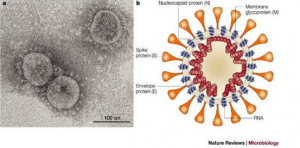Coronavirus (COVID-19)
What is Coronavirus?
Coronavirus is a type of virus that causes infectious disease. The name coronavirus is derived from the Latin word corona, meaning “Crown” or “Halo”, which refers to the characteristics appearance reminiscent of a crown or solar corona around the virions. They are enveloped viruses with a positive sense single-stranded RNA genome.
Coronaviruses are a group of related viruses that causes diseases in mammals and birds. In humans, coronaviruses causes respiratory tract infections that can be mild such as some cases of the common cold and others that can be lethal such SARS, MERS and COVID-19.
- SARS (Severe Acute Respiratory Syndrome)
It is an animal virus from bats that spread to civet cats and first infected humans in southern china in year 2002.The affected people were 8000 out of which 800 death took place so the mortality rate was 10%.
- MERS (Middle East Respiratory Syndrome)
It was passes to humans from dromedary Camel in Saudi Arabia in year 2012. The total affected people were 2500 out of which 850 death took place so the mortality rate was 34%.
- COVID-19
The transmission of COVID-19 is still known, but it is said to be transmitted from bats. It is not very fatal like others but is pandemic. The first case of human infected was found in the Chinese city of Wuhan in December 2019.
COVID-19
Previously known as 2019 novel Coronavirus was officially named as COVID-19 by WHO. The animal source of COVID-19 has not yet been identified but the original host is thought to be bats. The source of the coronavirus is believed to be a “wet market” in Wuhan which sold both dead and live animals including fish and birds.
How is coronavirus spread
Like cold and flu, the virus is spread via droplets when a person coughs or sneezes. The droplets land on surface and are picked up on the hands of others and spread further. People catch the virus when they touch their infected hands to their mouth nose or eyes.
Symptoms
Initial symptoms include fever, dry cough, tiredness and shortness of breath. These symptoms may appear 2-14 days after exposure of the person to the virus.
Age Group of people likely to be affected
While people of all ages can be affected by the disease, older adults and people who have a severe underlying medical condition like heart, lung disease or diabetes seem to be at higher risk for developing more serious complications.
Precautions that can be taken
- Wash your hands frequently– Washing hands with soap and water or using alcohol-based hand rub kills viruses that may be on hands.
- Maintain social distancing– When someone coughs or sneezes they spray small liquid droplets from their nose or mouth which may contain virus. If you are too close you can breathe in the droplets, thus maintain at least 1 meter (3 feet) distance between yourself and anyone who is coughing of sneezing.
- Avoid touching eyes, nose and mouth– Hands touch many surface and can pick up viruses. Once contaminated, hands can transfer the virus to your eyes, nose or mouth from where it can enter your body and make you sick.
- Practice respiratory hygiene-This means covering your mouth and nose with your bent elbow or tissue when you cough or sneeze. Then dispose of the used tissue immediately. By following good respiratory hygiene you protect the people around you.
- Stay informed and follow advice given by your healthcare provider– Stay informed on the latest development about COVID-19. Follow advice given by healthcare provider, national and local public health authority on how to protect yourself and others from COVID-19.
Cure/ Treatment
There is no specific treatment, although doctors are trialing existing drugs for viruses such as Ebola, Malaria and HIV. At present there is still research being done in labs all over the world for the cure of COVID-19.
It is very challenging. But also an amazing opportunity to unlearn, relearn, and test our capabilities and value systems. – Sudip Ralhan
Sources – https://www.who.int/

